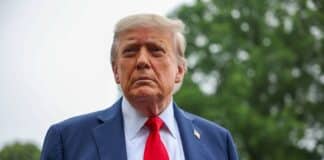Japan’s number two defense official says China and Russia’s military cooperation in the Indo-Pacific might indicate their plans to launch a Pearl Harbor-style attack on the U.S.
Japan attacked the United States on Dec. 7, 1941 in a surprise airstrike against the Pearl Harbor naval base that catapulted the U.S. into World War II.
Now, Japan’s second-highest defense official Yasuhide Nakayama is sounding the alarm that a similar attack against the U.S. might soon come from China.

As American Military News reports:
On Wednesday, Japan’s number two defense official said China and Russia are showing increased signs of military cooperation and their activities in the Pacific could show signs they plan to launch a Pearl Harbor-style attack on the U.S., similitar [sic] to how Japan did on Dec. 7, 1941, propelling the U.S. into World War II.
Speaking at a Hudson Institute event, Japanese State Defense Minister Yasuhide Nakayama said, “Seventy years ago, we attacked Pearl Harbor, but now the U.S. and Japan [are] very good allies, one of the best allies all over the world.” Nakayama went on to say now Russian naval forces “are really exercising just right in front of the western part of Honolulu, and so I don’t want to remind the 70 years ago, but we have to be careful of the exercising of the Russians.”
American Military News noted the significance of such a warning coming from someone in Nakayama’s position. As State Defense Minister, Nakayama is the direct deputy to Japan’s Defense Minister (seen below), the country’s top defense official.

American Military News then pointed to Russia’s involvement (here) with China:
In recent days, Russia’s fleet has conducted various naval drills near Hawaii, including practicing sinking an aircraft carrier. Some Russian ships have been reported operating within 35 nautical miles of Hawaii’s coastline. Amidst the nearby Russian naval drills, the U.S. Navy repositioned Carrier Strike Group (CSG) 1 in the Hawaiian Islands Operating Area.
Nakayama said, “We have to show the deterrence towards China, and not just China but also the Russians, because, as I told you, that they are doing their exercises together.”

“China and Russia are doing very good. They are friends. They are very good friends, I think. But on the other hand, they are creating their own missiles capability, their own submarine capability. They are sharing their knowledge together, even with academia, I guess, or [research and development],” Nakayama said. “. . .So we have to more focus on how to protect and not just protect, but how to hedge the risk.”
Russian officials have described their “missile and artillery firings” in the Pacific as an equipment check, according to The Washington Examiner. “In the course of practical measures, the warships jointly repelled a notional enemy’s air attack,” the Russian Pacific Fleet’s press office said Wednesday per state media. “The exercise was intended to check the reliable operation of shipborne weapons in a hot climate.”
To make matters worse, Russian President Vladimir Putin only weeks ago characterized relations with the United States as being at one of the “lowest points” since the Cold War. “We have a bilateral relationship that has deteriorated to its lowest point in recent years,” Putin said, as he praised President Donald Trump as “an extraordinary individual, talented individual.” Conversely, Putin said that Joe Biden was “radically different” from Trump, alluding to his distaste for Biden.
Nakayama went on to compare a potential nuclear attack by Russia or China—China’s own state-run media threatening as much—and the U.S. nuclear attacks on Hiroshima and Nagasaki, Japan during World War II.
“If some country shoot’s [a nuclear weapon] from their continent towards Honolulu, that missile’s . . . the warheads compared to Hiroshima, it’s 200 times more than Hiroshima,” Nakayama said. “So I’ve been to Hiroshima before and I went to the museum before, from that experience and the perspective, if 200 times more strong atomic bombs or torpedoes or missiles, warheads towards Honolulu, I think Honolulu will be erased from the map. So we have to think before using those powers, we have to think how to stop it.”

Nakayama also described the growing threat of invasion China poses against Taiwan, who is seen by China as a renegade province. For example, Chinese President Xi Jinping recently vowed to “utterly defeat” Taiwan’s “independence” in his speech during the Communist Party’s centenary celebration last week. Moreover, China’s state-run newspaper Global Times has characterized Japan’s defense of Taiwan’s sovereignty as a “tactic” to “conceal [Japan’s] own anti-China nature.” And just yesterday, the Global Times published an op-ed warning that “Japan would dig its own grave” if it interferes with Taiwan. (American Faith has reported on China’s hyperbolic rhetoric elsewhere.)
Finally, Nakayama encouraged cooperation between Japan and the U.S. as a means of keeping Chinese action in check:
“What we can do is show the deterrence and also [that an attack] or happening towards Taiwan, it’s straight to relate to not just Japan, but also the U.S.-Japan alliance even,” he said.
Watch Nakayama’s full interview here:
But this cooperation is already underway. In fact, the Guam National Guard recently began participating in Exercise Orient Shield, an ongoing exercise between the Japanese Ground Self Defense Forces and the U.S. military that began in 1985. Orient Shield aims to demonstrate “the U.S. resolve to support the security interests of friends and allies in the region,” according to the U.S. Army website.
Furthermore, the U.S. has been “fanning out” its Air Force across the Pacific, as reported by Forbes in June.
Jon Fleetwood is Managing Editor for American Faith.






